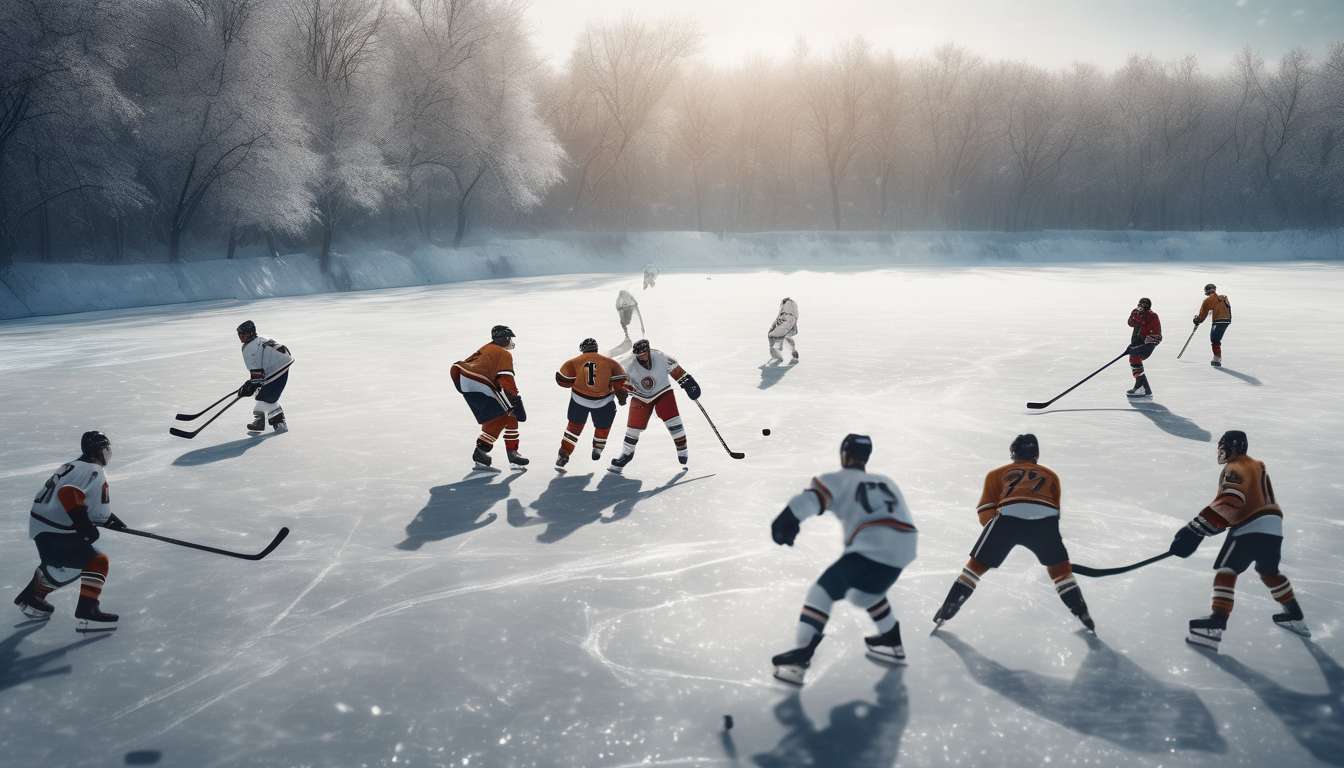Weather’s Impact on Outdoor Hockey
As outdoor hockey enthusiasts, we know firsthand how weather plays a pivotal role in shaping the dynamics of our beloved games. Whether it’s the crisp chill of a winter morning or the unexpected warmth of a sunny afternoon, each weather condition brings its own set of challenges and advantages to the rink.
We’ve experienced:
- The biting winds that test our resilience.
- The heavy snowfalls that transform our game into a true test of endurance and skill.
Ice conditions can shift dramatically with fluctuations in temperature, turning a smooth surface into a treacherous landscape. This variability keeps us on our toes, demanding adaptability and strategic thinking.
Embracing the Elements
Together, we’ve learned to embrace these elements, understanding that they:
- Influence our performance.
- Enhance the camaraderie and excitement of playing outdoors.
Strategies for Thriving
In this article, we explore:
- How different weather conditions impact our outdoor hockey games.
- The strategies we employ to thrive in them.
By understanding and adapting to these conditions, we not only maintain our performance but also enrich our overall outdoor hockey experience.
Impact of Freezing Temperatures
Freezing temperatures dramatically change the dynamics of outdoor hockey games by affecting ice quality and player performance.
When the temperature drops, the ice becomes harder and faster, creating a slick surface that demands new levels of adaptability from us as players. We must adjust our skating and puck-handling techniques to match these shifting ice conditions.
It’s a challenge that brings us together, fostering a sense of camaraderie as we adapt to the elements.
As the mercury dips, our endurance is tested. We have to manage both our energy and our equipment. Key considerations include:
- Ensuring our skates are sharp
- Wearing layers warm enough to maintain peak performance
The cold can be biting, but it strengthens our resolve and connects us, reminding us why we love this game.
The shared experience of battling the elements enhances our sense of belonging within the team, turning every freezing match into a testament of our collective resilience.
Challenges of High Winds
High winds on the rink demand that we adjust our strategies and communication to maintain control and cohesion during the game.
When gusts sweep across the ice:
- Our passes can go astray.
- Our shots may miss their mark.
It’s crucial that we stay adaptable, reacting quickly to the wind’s unpredictable nature. Staying vocal on the ice helps us remain in sync despite the bluster, ensuring that each play is executed with precision.
Wind can also affect the temperature, which in turn impacts ice conditions.
- Colder winds might harden the ice, making it slicker and faster.
- Warmer gusts could soften it, changing how the puck glides.
We’re constantly assessing these shifts to fine-tune our tactics.
Our team unity becomes our strength, as we rally together to face these elements head-on. By embracing the challenges of high winds, we deepen our connection and enhance our collective resilience, embodying the spirit of outdoor hockey.
Influence of Heavy Snowfall
Heavy snowfall challenges us to maintain visibility and puck control as we navigate the ice. Together, we face the thrill of the snowflakes swirling around us, transforming the rink into a winter wonderland.
Temperature changes affect not only our comfort but also the ice conditions, making them unpredictable. Our skates crunch over the fresh powder, adding an extra element to our game. It’s in these moments that our community spirit shines, as we rely on each other to adapt and communicate effectively.
Our adaptability becomes crucial as we adjust our strategies to the changing conditions. Key adjustments include:
- Passing the puck with more precision.
- Ensuring every shot demands our full concentration.
We embrace the camaraderie, knowing we’re all in this together, battling the elements to enjoy the game we love.
The shared experience of playing in heavy snowfall strengthens our bond, reminding us of why we gather on the ice, no matter the weather’s whimsy.
Unpredictability of Rain
Rain adds an unexpected challenge to our outdoor hockey games, turning the ice slick and testing our agility. When raindrops fall, they create a layer of water on the surface, making it difficult to maintain control over our skates.
The temperature also plays a crucial role, as warmer days may lead to softer ice, further complicating our maneuvers. We often find ourselves slipping, sliding, and laughing together as we adapt to these ever-changing conditions. The unpredictability of rain requires us to sharpen our skills and deepen our camaraderie.
Our adaptability becomes our greatest asset in these moments. We adjust our techniques by:
- Learning to read the ice conditions
- Anticipating how the puck will behave
Rain makes us more aware of each other’s movements, fostering a sense of unity. We rely on shared experiences and teamwork to navigate these challenges.
Together, we embrace the unpredictability of rain, transforming obstacles into opportunities for growth and connection.
Impact of Sunny Weather
Sunny weather enhances our outdoor hockey games by creating a vibrant atmosphere and boosting our energy on the ice. The warmth of the sun on our backs fosters a sense of camaraderie, uniting us in the shared joy of the game.
As temperatures rise, we find ourselves more alert and engaged, which enhances our performance. However, it is important to stay mindful of how these conditions affect the ice.
Higher temperatures can lead to softer ice surfaces, which might challenge our usual playing style. We adapt by adjusting our strategies and techniques to maintain the pace and quality of the game. It’s in these moments that our team’s adaptability shines. We tweak our movements and communication to suit the ever-changing conditions.
Gathering under the bright sky, we feel a profound sense of belonging, knowing we’re part of a community that embraces both the challenges and the joys that sunny weather brings to our beloved sport.
Effects of Changing Ice Conditions
As outdoor hockey enthusiasts, we constantly face the challenge of adapting to the ever-changing ice conditions that can impact our play. Temperature fluctuations can transform a smooth, glass-like surface into a bumpy, unpredictable terrain in no time.
- When temperatures rise, the ice becomes softer and slower, demanding more effort from us to glide and maneuver.
- Conversely, when the temperature drops, the ice hardens, often causing cracks and creating a faster, more challenging game.
These changes in ice conditions test our skills and adaptability. We find ourselves adjusting our techniques and strategies on the fly, all while maintaining our camaraderie and shared passion for the game.
Our sense of belonging strengthens as we collectively tackle these challenges, knowing that each shift in temperature adds a layer of complexity to our beloved sport.
It’s this shared experience of adapting to nature’s whims that bonds us, enhancing our connection to each other and the outdoor hockey community.
Strategies for Adapting Outdoors
To thrive in outdoor hockey, we must develop effective strategies for adjusting our play to the unpredictable elements.
We face varying temperatures and ever-changing ice conditions that challenge our adaptability. It’s essential to:
-
Read the ice closely: Notice when it’s slicker or rougher than usual.
-
Adjust to temperature changes:
- Cold temperatures: Hard ice can lead to faster puck movement, so focus on precision in passes and shots.
- Warm temperatures: Softer ice might slow down puck dynamics, requiring adjustments in speed and control.
Communication is key.
- Share observations about ice conditions with teammates to adapt strategies collectively.
- Stay in sync with each other to foster unity and ensure everyone feels included in the decision-making process.
Maintain flexibility in gameplay to respond quickly to unexpected changes, keeping us ready for whatever the weather throws our way.
Together, we can tackle any challenge.
Enhancing Performance in All Conditions
To enhance our performance in all weather conditions, we must fine-tune our skills and equipment to meet the demands of outdoor play. Embracing the challenges of varying temperatures and ice conditions, adaptability becomes our cornerstone. Together, we can transform unpredictable weather into opportunities for growth.
We can’t rely solely on technology; our sense of belonging strengthens when we unite, sharing tips and strategies. By adjusting our skates for optimal grip in different ice conditions, we improve control. Warm-ups tailored for varying temperatures ensure our bodies are ready for action, preventing injuries and enhancing endurance.
Let’s invest in gear that withstands the elements, ensuring we remain focused on the game.
- Wearing layers that breathe and insulate helps regulate body temperature, keeping us comfortable and agile.
Communication on the ice becomes crucial as conditions change, so let’s foster an environment where everyone feels empowered to share insights and support one another.
Together, we thrive.
How do outdoor hockey games affect local wildlife and ecosystems during different weather conditions?
We’ve noticed that outdoor hockey games can have varying impacts on local wildlife and ecosystems depending on the weather conditions.
Warmer temperatures might:
- Disrupt habitats.
Cold weather could:
- Lead to ice formation.
- Affect water sources.
It’s crucial to consider these factors to minimize any negative consequences on the environment.
Adapting our practices and ensuring responsible event planning can help protect the wildlife and ecosystems that surround outdoor hockey venues.
What are the historical records or notable events of outdoor hockey games impacted by extreme weather conditions?
We’ve researched historical records and notable events of outdoor hockey games impacted by extreme weather conditions. It’s fascinating to see how Mother Nature influences these games, creating iconic moments in hockey history.
Weather Conditions Impacting Games:
Blizzards to Heatwaves: Weather can truly test the players’ skills and adaptability. These extreme conditions often lead to unforgettable games that showcase the resilience and determination of both teams.
Iconic Moments in Hockey History:
-
Blizzards: Players often have to navigate through reduced visibility and icy playing surfaces, making the game more challenging.
-
Heatwaves: High temperatures can affect the ice quality, making it harder to maintain a smooth playing surface and testing the endurance and stamina of the players.
Resilience and Determination: These games are memorable not just for the weather conditions but for the sheer perseverance shown by the teams involved.
Overall, extreme weather conditions add an unpredictable element to outdoor hockey games, making them a unique spectacle in the world of sports.
How do emergency services and medical teams prepare for weather-related incidents during outdoor hockey games?
We ensure safety by coordinating with emergency services and medical teams.
Preparation includes:
- Monitoring weather forecasts
- Having protocols in place for any weather-related incidents during outdoor hockey games
Our team collaborates closely with these professionals to establish:
- Clear communication channels
- Emergency response plans
By working together, we aim to provide a safe environment for players and spectators alike, ensuring everyone’s well-being is a top priority.
Conclusion
In conclusion, weather plays a crucial role in outdoor hockey games, affecting everything from ice conditions to player performance.
Being prepared for various weather conditions is essential for success on the ice. These include:
- Freezing temperatures
- High winds
- Heavy snowfall
- Rain
- Sunny weather
Adapting to these challenges and developing strategies to thrive in all conditions is key to enjoying and excelling in outdoor hockey.
So, embrace the elements, stay flexible, and keep your game strong no matter what Mother Nature throws your way.

